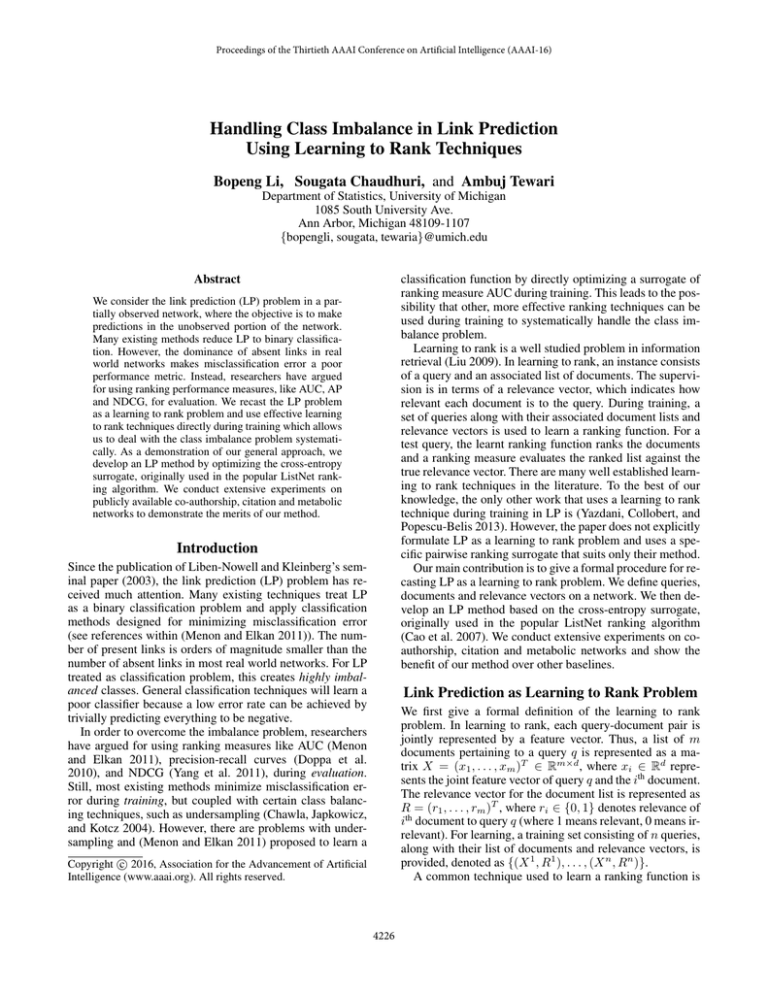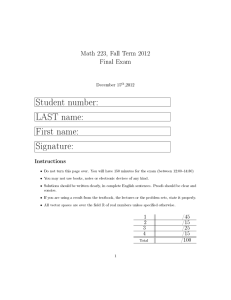
Proceedings of the Thirtieth AAAI Conference on Artificial Intelligence (AAAI-16)
Handling Class Imbalance in Link Prediction
Using Learning to Rank Techniques
Bopeng Li, Sougata Chaudhuri, and Ambuj Tewari
Department of Statistics, University of Michigan
1085 South University Ave.
Ann Arbor, Michigan 48109-1107
{bopengli, sougata, tewaria}@umich.edu
classification function by directly optimizing a surrogate of
ranking measure AUC during training. This leads to the possibility that other, more effective ranking techniques can be
used during training to systematically handle the class imbalance problem.
Learning to rank is a well studied problem in information
retrieval (Liu 2009). In learning to rank, an instance consists
of a query and an associated list of documents. The supervision is in terms of a relevance vector, which indicates how
relevant each document is to the query. During training, a
set of queries along with their associated document lists and
relevance vectors is used to learn a ranking function. For a
test query, the learnt ranking function ranks the documents
and a ranking measure evaluates the ranked list against the
true relevance vector. There are many well established learning to rank techniques in the literature. To the best of our
knowledge, the only other work that uses a learning to rank
technique during training in LP is (Yazdani, Collobert, and
Popescu-Belis 2013). However, the paper does not explicitly
formulate LP as a learning to rank problem and uses a specific pairwise ranking surrogate that suits only their method.
Our main contribution is to give a formal procedure for recasting LP as a learning to rank problem. We define queries,
documents and relevance vectors on a network. We then develop an LP method based on the cross-entropy surrogate,
originally used in the popular ListNet ranking algorithm
(Cao et al. 2007). We conduct extensive experiments on coauthorship, citation and metabolic networks and show the
benefit of our method over other baselines.
Abstract
We consider the link prediction (LP) problem in a partially observed network, where the objective is to make
predictions in the unobserved portion of the network.
Many existing methods reduce LP to binary classification. However, the dominance of absent links in real
world networks makes misclassification error a poor
performance metric. Instead, researchers have argued
for using ranking performance measures, like AUC, AP
and NDCG, for evaluation. We recast the LP problem
as a learning to rank problem and use effective learning
to rank techniques directly during training which allows
us to deal with the class imbalance problem systematically. As a demonstration of our general approach, we
develop an LP method by optimizing the cross-entropy
surrogate, originally used in the popular ListNet ranking algorithm. We conduct extensive experiments on
publicly available co-authorship, citation and metabolic
networks to demonstrate the merits of our method.
Introduction
Since the publication of Liben-Nowell and Kleinberg’s seminal paper (2003), the link prediction (LP) problem has received much attention. Many existing techniques treat LP
as a binary classification problem and apply classification
methods designed for minimizing misclassification error
(see references within (Menon and Elkan 2011)). The number of present links is orders of magnitude smaller than the
number of absent links in most real world networks. For LP
treated as classification problem, this creates highly imbalanced classes. General classification techniques will learn a
poor classifier because a low error rate can be achieved by
trivially predicting everything to be negative.
In order to overcome the imbalance problem, researchers
have argued for using ranking measures like AUC (Menon
and Elkan 2011), precision-recall curves (Doppa et al.
2010), and NDCG (Yang et al. 2011), during evaluation.
Still, most existing methods minimize misclassification error during training, but coupled with certain class balancing techniques, such as undersampling (Chawla, Japkowicz,
and Kotcz 2004). However, there are problems with undersampling and (Menon and Elkan 2011) proposed to learn a
Link Prediction as Learning to Rank Problem
We first give a formal definition of the learning to rank
problem. In learning to rank, each query-document pair is
jointly represented by a feature vector. Thus, a list of m
documents pertaining to a query q is represented as a matrix X = (x1 , . . . , xm )T ∈ Rm×d , where xi ∈ Rd represents the joint feature vector of query q and the ith document.
The relevance vector for the document list is represented as
R = (r1 , . . . , rm )T , where ri ∈ {0, 1} denotes relevance of
ith document to query q (where 1 means relevant, 0 means irrelevant). For learning, a training set consisting of n queries,
along with their list of documents and relevance vectors, is
provided, denoted as {(X 1 , R1 ), . . . , (X n , Rn )}.
A common technique used to learn a ranking function is
c 2016, Association for the Advancement of Artificial
Copyright Intelligence (www.aaai.org). All rights reserved.
4226
to learn a scoring function f , from which we can get the
ranked list by sorting the scores. For a document list X, f
gives a score vector s = f (X) ∈ Rm , where si is score of
the ith document. Any ranking measure can be used to judge
the quality of a ranking function, by comparing the output
ranked list to the ground truth relevance vector.
In the LP problem, a partially observed network is represented as G = (V, E), where V is the set of nodes and E is
the set of links. Let there be N nodes with each node having a d dimensional feature vector (node information). We
make the natural assumption that the presence of a link between 2 nodes is a function of their joint feature vector. This
assumption is made for any feature based LP model. The
training data is constructed as follows. Each node in V , in
turn, acts as a query node while all other nodes work as documents. For query node q, the joint feature vector of q and
d2
document node i is vec(xq x
i ) ∈ R , where vec(·) is the
vectorization operator on matrices. The feature matrix for
the list of documents associated with node q is represented
2
as X q ∈ R(N −1)×d , where the ith row is the joint feature
vector for node i and q. The relevance vector is obtained
from the network topology, i.e., Rq ∈ {0, 1}N −1 , where,
the ith entry of Rq is 1 if and only if there is a link present
between nodes q and i. Thus, the training data consists of
N (matrix, vector) pairs, i.e. {(X 1 , R1 ), . . . , (X N , RN )},
where (X q , Rq ) corresponds to node q acting as a query.
Once the training data is prepared, a scoring function
f will be learnt from it. We use a linear scoring function
parametrized by a matrix M , and the score vector produced for instance X q is fM (X q ) = sq ∈ RN −1 , where
sqi = vec(M ), vec(xq x
i ) (·, · is inner product). Note
that this is same as the bilinear model sqi = x
q M xi . In
the general framework, the parameter matrix M is learnt
via minimization of (regularized) empirical version of some
ranking surrogate φ : RN −1 × {0, 1}N −1 → R, as follows:
φ(sq (M ), Rq ).
(1)
min L(M ) = λ Ω(M ) +
M
Table 1: NDCG@10
Dataset Entropy RankSVM AUC-logistic Undersampled 0-1
CiteSeer 0.169
0.161
0.161
0.157
Cora
0.071
0.063
0.063
0.061
WebKB
0.174
0.127
0.127
0.122
NIPS
0.257
0.220
0.220
0.222
Metabolic 0.067
0.059
0.058
0.057
Table 2: Average Precision
Dataset Entropy RankSVM AUC-logistic Undersampled 0-1
CiteSeer 0.114
0.105
0.105
0.100
Cora
0.045
0.040
0.040
0.040
WebKB
0.177
0.140
0.140
0.140
NIPS
0.192
0.167
0.167
0.168
Metabolic 0.067
0.066
0.066
0.066
timization of AUC (Menon and Elkan 2011) and undersampled 0-1 error (Chawla, Japkowicz, and Kotcz 2004).
Due to page limit, here we only show the results of using
NDCG@10 and AP as evaluation measures in Table 1 and 2.
For both measures, our method (named “Entropy”) consistently outperforms baselines in all the datasets. We also observe that undersampled 0-1 error performs almost as good
as RankSVM and surrogate optimization of AUC. Further details on dataset descriptions, baselines, experiments setup,
and more empirical results can be found in the full version
of the paper at http://arxiv.org/abs/1511.04383.
Acknowledgements
We acknowledge support of NSF under grant IIS-1319810.
References
Cao, Z.; Qin, T.; Liu, T.-Y.; Tsai, M.-F.; and Li, H. 2007.
Learning to rank: from pairwise approach to listwise approach.
In Proceedings of the 24th ICML, 129–136. ACM.
Chawla, N. V.; Japkowicz, N.; and Kotcz, A. 2004. Editorial: special issue on learning from imbalanced data sets. ACM
SIGKDD Explorations Newsletter 6(1):1–6.
Doppa, J. R.; Yu, J.; Tadepalli, P.; and Getoor, L. 2010.
Learning algorithms for link prediction based on chance constraints. In Proceedings of ECML PKDD 2010: Part I, 344–
360. Springer-Verlag.
Liben-Nowell, D., and Kleinberg, J. 2003. The link prediction
problem for social networks. In Proceedings of CIKM 2003,
556–559.
Liu, T.-Y. 2009. Learning to rank for information retrieval.
Foundations and Trends in Information Retrieval 3(3):225–
331.
Menon, A. K., and Elkan, C. 2011. Link prediction via matrix
factorization. In Proceedings of ECML PKDD 2011: Part II,
437–452. Springer-Verlag.
Yang, S.-H.; Long, B.; Smola, A.; Sadagopan, N.; Zheng, Z.;
and Zha, H. 2011. Like like alike: joint friendship and interest
propagation in social networks. In Proceedings of the 20th
International Conference on WWW, 537–546. ACM.
Yazdani, M.; Collobert, R.; and Popescu-Belis, A. 2013.
Learning to rank on network data. In Mining and Learning
with Graphs, EPFL-CONF-192709.
q∈V
Here, s (M ) shows explicit dependence of the score vector on M , Ω is a regularization function to prevent overfitting, and λ is a tuning parameter. As an instantiation of the
general framework, we give mathematical definitions of the
cross-entropy loss, which was used as a ranking surrogate
in ListNet (Cao et al. 2007). For score vector s ∈ RN −1
2
induced from document matrix X ∈ R(N −1)×d and relevance vector R ∈ {0, 1}N −1 , the cross-entropy loss is deN
−1
fined as
φLN (s, R) = −
PR (i) log(Ps (i)),
(2)
q
where PR (i) =
Ri
Ne−1
k=1
i=1
eR k
and Ps (i) =
si
Ne−1
k=1
esk
. The gra-
dient ∇M φLN (s(M ), R) can be easily calculated and a gradient descent algorithm can be used for optimization.
We conduct experiments on 5 popular, publicly available network datasets, including 3 citation networks (CiteSeer [N =3312], Cora [N =2708], WebKB [N =877]), 1 coauthorship network (NIPS [N =2037]) and 1 metabolic network (Metabolic [N =668]). In the experiments, our method
is compared against 3 baseline methods: RankSVM (Yazdani, Collobert, and Popescu-Belis 2013), surrogate op-
4227




